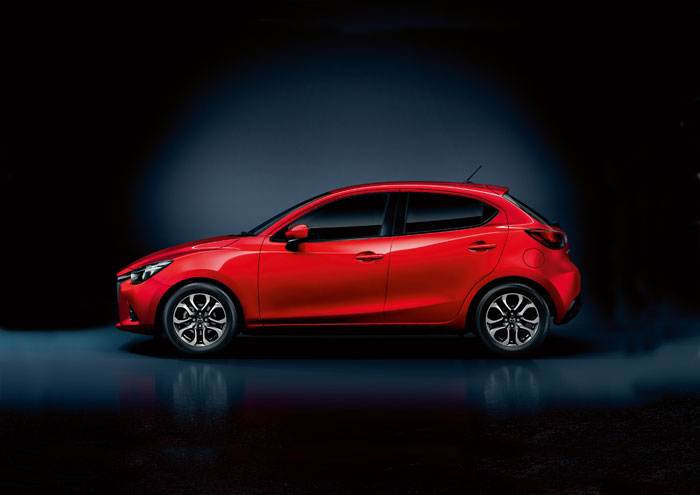'We are a challenger brand and also one that is easy to do business with.

The new Mazda 2. Picture: Supplied
Our future is aimed at being a legitimate alternative to the established premium brands. In December 2014 and January 2015 we were the fastest growing brand in South Africa.” These were the words of David Hughes, CEO of the re-established Mazda SA, during last week’s Knysna launch of the latest offering, the third generation of the Mazda 2.
Very positive statements indeed from the dynamic Australian appointed to put Mazda back on the map in South Africa following a less than exciting history within the Samcor and Ford corporations.
The new B-segment subcompact complements the current range of the Mazda CX-5, Mazda 6 and Mazda 3, all of which follow the Kodo Soul of Motion design with a full range of Skyactiv technology.
Making up 17% of the South African passenger car market, the B segment is highly competitive. Petrol is the preferred fuel choice in this segment at present – as is a manual transmission – but Mazda SA believes they can change this mindset. Available in four specification levels – Active, Dynamic, Individual and Hazumi – Mazda offers two engines, one petrol and one diesel, both with a capacity of 1.5 litres.
The entry-level Active is only available with the new six-speed manual transmission, whereas the Dynamic and Individual models offer the manual as standard with the option of a six speed automatic. The diesel-powered Hazumi has the automatic transmission as standard.
All petrol models use the Skyactiv-G 1.5-litre, four-cylinder, 16-valve, DOHC, S-VT engine. This 12:1 compression ratio unit delivers 82kW at 6 000rpm and 145Nm of torque at 4 000rpm.
The Skyactiv-D is also a 1.5-litre 16-valve DOHC engine, but the diesel provides maximum power of 77kW at 4 000rpm and 250Nm of torque between 1 500 and 2 500rpm.
Fuel consumption is claimed at 5.5 l/100km for the petrol models with manual transmission and 5.7 l/100km for the automatic. The diesel with automatic transmission has a claimed consumption of 4.4 l/100km.
Specification levels are high across the entire range.
Standard equipment for the entry-level Active model includes 15-inch steel wheels, halogen headlights, power windows, cloth-trimmed seats, driver’s seat height adjustable, rear seat backrest with 60:40 split, air conditioning, height and reach adjustable steering wheel, front vanity mirrors, four-function trip computer, ABS, EBD, EBA, driver and front passenger SRS airbags, childproof rear door locks, Isofix fastening points, keyless ignition, an audio system with AM/FM tuner, single CD player, MP3 compatible, auxiliary audio input jack, four speakers, USB port and steering wheel satellite controls.
The Dynamic model adds 15-inch alloy wheels, front fog lamps, 7-inch full-colour touch screen display (MZD Connect), Bluetooth phone and audio capability, internet radio integration, multi-function command control, audio system with six speakers, power fold mirrors and a leather covered gearshift knob, handbrake lever and steering wheel.
Next up, the Individual model gets 16-inch alloy wheels, a chrome exhaust extension, body-coloured front upper grille trim and auto on/off headlamp function.
The range-topping diesel powered Hazumi adds climate control, half-leather seat trim, satellite navigation and Dynamic Stability Control.
Body styling at the rear is similar to the outgoing model, but the Mazda 2’s front end has a far more aggressive look and mirrors its siblings in the Japanese manufacturers’ stable. The body and chassis have also undergone considerable upgrades. The bodywork has been strengthened but overall weight reduced by 7kg – all part of the Skyactiv philosophy.
Climb into the Mazda 2 and it is immediately obvious this is a driver-orientated car. Seating and control adjustments are good, allowing one to find the perfect set-up. Instrumentation and switchgear are well positioned and easy to use. On all but the entry-level Active a large 7-inch touch screen mounted on the centre dash top provides ancillary information and is coupled to a centre console commander control panel, which is used for satnav on the Hazumi. From the Dynamic range up the Mazda 2 offers a connectivity system allowing access to the internet and social networks.
In all its guises the new Mazda 2 is a well-balanced car, with a chassis and steering set-up that allows any driver, from school run chauffeurs to budding touring car entrants to enjoy the potential. This was proven at launch as roads were wet and slippery but the Mazda 2 remained surefooted at all times.
Both engines performed well as did the transmissions, with the new automatic proving an excellent alternative for those spending a lot of time in the urban cycle.
The new Mazda 2 is a worthy successor to its predecessor and should find favour with many new clients. It is priced keenly against the Ford Fiesta, Hyundai i20, Volkswagen Polo and Renault Clio, which the company sees as its main competitors.
The Mazda revival goes on with a facelifted BT-50 on its way and the CX-3 due in the third quarter of this year – testimony Mazda are determined to make their presence felt in South Africa.
They have the product, of that there is no doubt, but it remains to be seen whether the market agrees.
Download our app






